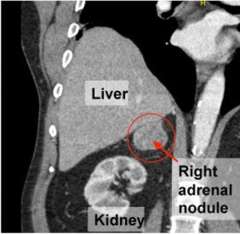Cushings Syndrome
Find your care
We deliver effective, minimally invasive treatments in a caring environment. Call to connect with an expert in endocrine surgery.
What is Cushing's syndrome (hypercortisolism)?
Cushing’s syndrome is a constellation of signs and symptoms cause by prolonged exposure to excessive levels of cortisol. Cortisol is normally released by the adrenal glands in response to physical or emotional stress. Cushing’s syndrome arises in people whose cortisol levels are more than double what normal people experience during the stress of everyday life.
Symptoms
The most common signs and symptoms of Cushing’s syndrome are obesity/weight gain (particularly around the midsection/belly), a round and sometimes reddened face, easy bruising (typically multiple bruises are present on the arms and legs), high blood pressure, and menstrual changes. Many patients experience high blood sugar levels and either diabetes or prediabetes.
Cushing’s syndrome is most often seen in people who are prescribed cortisol or cortisol-like drugs (collectively called glucocorticoids) for the treatment of inflammatory conditions. Glucocorticoids are steroid hormones that have the principal function of moving glucose (sugar) to different parts of the body, and are distinct from the steroids that athletes take to enhance performance.
Somewhere between 1 to 3 per million people have endogenous Cushing’s syndrome, meaning that they have a medical condition, most often a tumor of the pituitary gland or one of the adrenal glands, causing too much cortisol to be secreted within their own bodies.
Endogenous Cushing’s syndrome is a dangerous, often lethal condition that degrades health by causing metabolic syndrome. Most cases of endogenous Cushing’s syndrome require neurosurgical treatment of a pituitary tumor, and about 15% of patients require removal of an adrenal gland harboring a cortisol-producing tumor. Again, adrenal surgery for Cushing’s syndrome is almost always accomplished endoscopically.
Diagnosis
There are several ways to diagnose endogenous Cushing’s syndrome, including measurement of the cortisol level in blood and/or urine, the ACTH level, and the DHEA-S level. A common way to diagnose endogenous Cushing’s syndrome is by performing a dexamethasone suppression test. Alternative Names: Hypercortisolism
Risk factors for Cushing's syndrome are adrenal or pituitary tumors, long-term therapy with corticosteroids, and being female.
Signs and tests:
Tests to confirm high cortisol level:
- cortisol, urine
- dexamethasone suppression test
- serial serum cortisol levels
Tests to determine the cause:
- ACTH
- cranial MRI or cranial CT scan may show pituitary tumor
- abdominal CT may show adrenal mass
- General findings:
- glucose test is elevated
- potassium test may be low
- white blood cell count may be elevated

Treatment
Treatment depends upon the cause of the disorder. In Cushing's syndrome caused by drug therapy with corticosteroids, the drug dose must be slowly decreased under medical supervision.
In Cushing's disease caused by a pituitary tumor, surgery to remove the tumor is recommended. Radiation is sometimes needed as well. Hydrocortisone (cortisol) replacement therapy is needed after surgery. In some cases, life-long cortisol-replacement therapy becomes necessary.
Cushing's syndrome caused by an adrenal tumor is usually treated by surgical removal of the tumor. If the tumor cannot be removed, certain medications can suppress the secretion of cortisol.
In Cushing's syndrome caused by a tumor secreting ACTH, removal of the tumor is the best way to treat the Cushing's syndrome. Cortisol replacement therapy is needed after surgery until cortisol production resumes. In some cases, life-long therapy with cortisone drugs becomes necessary.
Find your care
We deliver effective, minimally invasive treatments in a caring environment.
Call to connect with an expert in endocrine surgery.